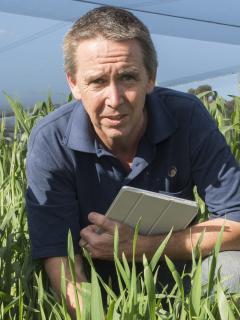Wheat growers are set to benefit from a new Department of Agriculture and Food research project that seeks to improve measures to protect wheat crops from the fungal leaf disease, powdery mildew.
The prevalence of wheat powdery mildew pathogen has increased in recent years, due to the widespread cultivation of susceptible varieties and favourable seasonal conditions.
The disease has been widespread across the Northern Agricultural Region for the past two years, due to early plantings and good ongoing rains.
Department research officer Geoff Thomas said the two year project aimed to provide a better understanding of variability in the powdery mildew pathogen across the grainbelt and how the disease interacted with the wheat plant.
“This base-level study will research the epidemiology of the pathogen, investigate if there are differences in the virulence of the pathogen regionally and examine the susceptibility of a range of wheat varieties at different growth stages of the plant,” Mr Thomas said.
“Preliminary research will also be undertaken on the influence of crop nutrition and environmental conditions on the interaction between the plant and the disease.”
Department staff will collect samples of powdery mildew from across the grainbelt and test their virulence on a selection of commercial and indicator varieties in glasshouse trials.
The results of the project are expected to assist disease risk assessments and refine paddock management and crop treatment strategies for powdery mildew.
The research is part of the department’s $20 million Boosting Grains Research and Development project’s Flagship initiative, made possible by Royalties for Regions.
This season, fungicides applied at sowing on seed or fertiliser and as foliar applications in-crop have been widely deployed to manage wheat powdery mildew.
Department and agribusiness trials in 2015 showed that fungicide applications for powdery mildew gave an average eight per cent yield response, with responses in one trial of more than 20 per cent.
“Powdery mildew is highly airborne and develops quickly,” Mr Thomas said. “The best responses are usually seen when fungicide is applied before the disease becomes severe or has reached the flag leaf stage.”
More information about powdery mildew in wheat and powdery mildew treatment options is provided on the department website. To report the disease, use PestFax Reporter using the link available on the department website.

Media contacts: Jodie Thomson/Megan Broad, media liaison +61 (0)8 9368 3937
